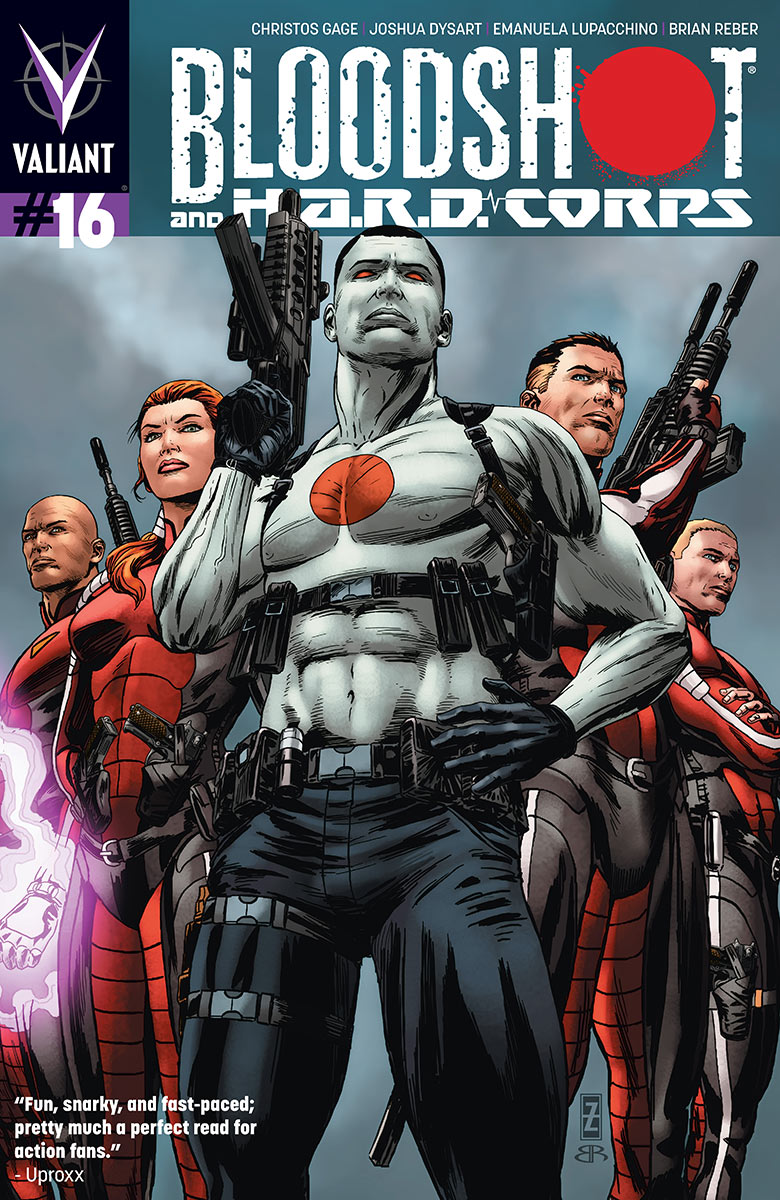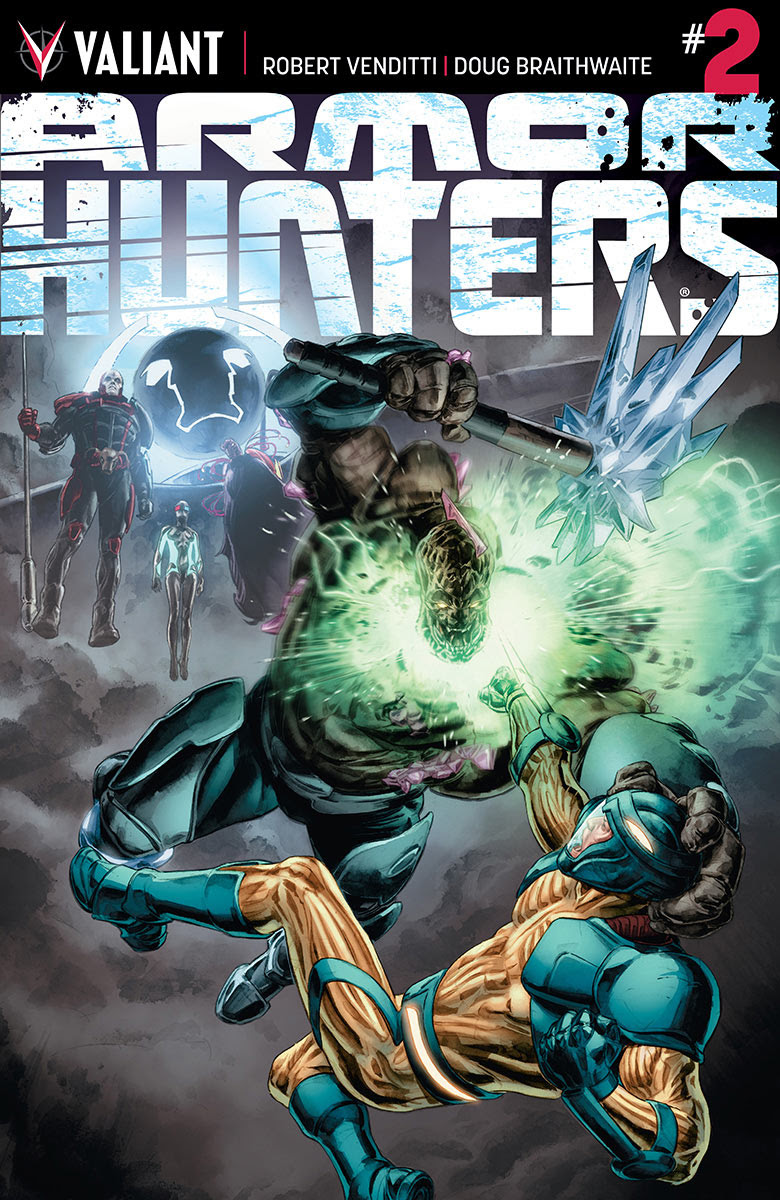Launching a comic on its own is a difficult proposition in its own right, but to carry on from the vaunted start of a previous creative team? That’s even more difficult, as you need to build off of what preceded your run, and you have to develop what you want your work to be all about. Throwing in a name change and making it a team book, like writers Josh Dysart and Christos Gage had to do as well? Sheesh. That is one hell of a challenge, but both writers have proven up to the task so far in “Bloodshot and H.A.R.D. Corps”, a title that is action packed, highly entertaining and perpetually surprising.
We talked to Gage about how they’re working together to develop this title’s new identity, the exciting artistic partners they get the chance to work with, how noted lone wolf Bloodshot will work with a team, and much more. Thanks to Gage for chatting with us, and check out some art from this week’s issue #16 while you’re at it.

Gage: First and foremost, it needed to make sense why Bloodshot would be part of this at all. He spent the first year plus of his book trying to escape Project Rising Spirit, and now that he has, he’s back working for them? Why would he do that? The meat of our story is in that very question. A team of people who all get along great and trust each other implicitly is wonderful in real life, but not so interesting to read about. Fortunately, that’s not the case here. Not at all.
On top of that, you’re co-writing with Josh Dysart on this book. What is your process working together, and how has the experience been so far?
Gage: It’s sort of the reverse of how I worked with Mike Costa on G.I. Joe Cobra. We talk about the story, then I do the first draft and Josh the second. It’s been a lot of fun. Josh and I have been friends for the better part of a decade, and we live near each other, so it’s easy to collaborate. But I always say that the only reason to have a writing team is if the whole creates something greater than the sum of its parts, and I very much think that’s the case here. We complement each other well…my sensibility is more mainstream comics while Josh is a bit more indy; he loves to research the hell out of stuff and keep it rooted in real science while I’m all about doing what is most fun and cool and then explaining it with, “Magic!” “Alien tech!” I think together, we maximize each other’s strengths, and I know I’m going to be a better writer on my solo projects as a result of the experience.
One of the things I’ve commented on your guys run so far with this book is it very much has an almost 80’s action movie vibe so far. Lots of posturing by hero and villain alike, but in the best sort of way. What are your influences for writing this book, and what’s the feel you’re going for?

Bloodshot himself has been a solo operative for much of his career, and now he’s not only working for the people who controlled him previously, but also with a team. What kind of trouble does that arise, and how do you fit someone like him in a team book?
Gage: We’ve provided some explanation as to why Bloodshot is doing this. His battle with Harada left his nanites damaged, so his blood needs a regular amino acid bath that only PRS can provide or he’ll die. Also, PRS CEO Morris Kozol has promised Bloodshot the truth about who he was before he became their killing machine. But I suspect many longtime fans feel like even those things don’t fully explain why Bloodshot would agree to a subservient role after fighting so hard for his independence. And they’re not wrong. Stay tuned.

Gage: We’ve spent a lot of time talking about Palmer’s motivations. To some degree, it’s the classic soldier’s motive: you’re not fighting for God or country or ideology or a paycheck, you’re fighting for the guy next to you. Palmer knows that without his veteran leadership, the rookies don’t stand a chance. Yet he’s well established as a guy who doesn’t much like people in general, so why is he so invested in this? Getting into his head will be a continuing and twisting journey.
So far, things have been pretty Toyo Harada-centric. What are the grand plans for this book, and how do you see this book fitting in with the rest of the Valiant line?
Gage: Rising as it did out of Harbinger Wars, and given the historic conflict between Project Rising Spirit and Harada, it made sense for the first arc to focus on that. But I’ve often told the rest of the team that for me, as a fan of the original ’90s H.A.R.D. Corps title, its fatal flaw was that it was too focused on the war with Harada. When Harada went down in Harbinger #25, the air went out of the book. And I don’t want that to happen again. (To be clear, I’m not suggesting I know where Harada is going in the future of the current Valiant universe.) Readers will already have seen references to the fact that PRS views H.A.R.D. Corps as a sort of superhuman Blackwater…paramilitary operatives for hire. Our next arc, “Get Some,” will really dive into that, having no connection to Harada whatsoever. As for fitting into the rest of the Valiant line, theoretically, H.A.R.D. Corps could get involved with any other title…and will be crossing over with at least one in the near future! (Editor’s Note: Gage is referencing this)

Gage: She’s terrific because she’s equally adept at action and character scenes. She can also pack a lot into a page, which has been crucial for our first arc, with all the new characters. In some ways she’s got the classic qualities of a George Perez with a very modern spin. It all comes down to storytelling ability, and she has that in spades.
Bart Sears is working on an upcoming arc, and to many, he’s someone who is synonymous with Valiant. What’s it like working with someone like Sears, and does the experience for you as a writer change knowing you’re writing for someone like him instead of, say, Emanuela?
Continued belowGage: Yeah, I was thrilled at the prospect of working with Bart, a true Valiant O.G. I always try to write to the strengths of any artist (when I know who the artist is), so for Bart I am going a bit more widescreen, more room to cut loose and go wild, because that’s what I love to see from him. That’s also made possible by the fact that it’s our second arc, so a lot of the setup is taken care of. All of us – me, Josh and editorial – are also working to create new villains who are in Bart’s wheelhouse. I’m very excited about the whole thing!
For you as a writer, what’s your favorite part about a project like this? It seems like it’d be a fun book to write, but that might be just me as a reader displacing on it.
Gage: It’s a ton of fun. Two of my favorite titles as a lad in the 80s were Suicide Squad and Strikeforce Morituri, and this book has the same quality. No one is safe…anything can happen. There’s a real excitement to a title like that; done right, it’s both exciting and scary to read it. But you have to make it mean something by getting the characters right and making them resonate with the readers, or no one will care if they live or die. Hopefully we’ll succeed. But yeah, it’s right up my alley, creatively.





